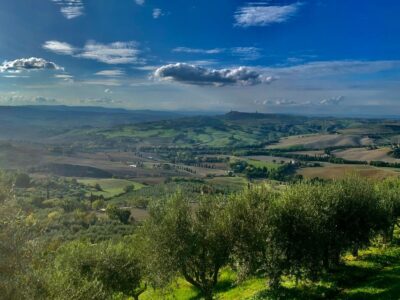Tuscany (Toscana) is a world-famous region of Italy. It is considered the cradle of the Renaissance. It is one of the most representative region of the whole country and it is well known for its beautiful cities like Florence, Siena, Pisa and other important towns. It is one of the biggest region of central Italy, too, in fact it has more than 3.500.000 citizens. However the real identity of Tuscany is revealed by discovering its several interesting boroughs like San Gimignano, Pienza, Montalcino, Cortona, Saturnia, Arezzo, Pitigliano. All of these towns are located in different areas of the region: Maremma, Chianti, Valdichiana, Val d’Orcia, Crete Senesi. Visit with us this great italian region! We provide guided tours, travel packages through the main areas and cities of Tuscany.
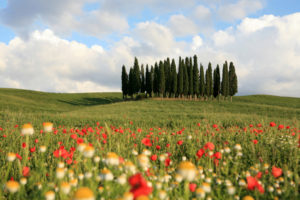
Tuscany has a large variety of geographic features: flat along the coast, mountains around the Appenino Tosco-Emiliano, green and sweet hills, where are produces many great wines and olive oils. The highest peaks are Monte Giovo (1991 mts) and Monte Abetone, which is, together with Monte Amiata (Siena), a winter ski location. Tuscany has many natural parks, each different to another. The main one is Parco della Maremma (or dell’Uccellina) which spreads out in front of the Monte Argentario, along the Tyrrenium coast, in Southern Tuscany. Other interesting parks are Migliarino Park around Pisa, Padule di Fucecchio, Casentino natural park and the north area, near Massa, the Alpi Apuane Park. Another interesting location is the Natural Path of the Bonifica in Valdichiana, that goes from Monte San Savino to Chiusi. The main rivers in Tuscany are the Arno, that crosses Florence, and more south, the Ombrone near Grosseto.
Food in Tuscany: you can enjoy a delicious foods based on a typical steak (called fiorentina) or a famous Ribollita soup, again you can enjoy the typical wild boar alla maremmana, the Pienza’s sheep cheese or the pici (special kind of pasta). Other important specialties are crostini, wild boar dishes, Ribollita (vegetables soup), Caciucco (fish dish from Livorno area). The coast offers several fish dishes, such as blue fish, tuna, etc.. Nevertheless do not forget to taste the sweet cake of Siena (panforte and ricciarelli) beside the great world-famous wine such as Chianti, Brunello di Montalcino, Morellino di Scansano, Montepulciano red-wine and many others. Tuscan artisans are great in many fields, such as textile (leather in particular) marbles (Carrara quarries) precious metals (silver and gold in Florence, Siena and Arezzo) and stones (alabaster in Volterra).
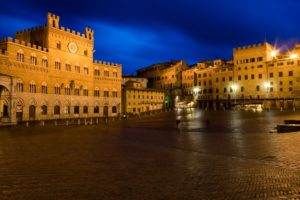
SIENA – Siena lives around its notorious Palio, a horse racing, that takes place twice a year in the main stunning square, called Piazza del Campo. Siena is an important regional city art, its wonderful Duomo is the main symbol, but this great city has many other monuments, renaissance noble palaces and museum that worth a visit. Artistic and culinary traditions live together in Siena: good food, great wines and other local specialties make this area a true paradise for food and wine lovers.
Siena surrounding areas in fact are famous for the production of great wines, olive oil and traditional sweets: in particular the town of Montalcino is world-famous for its red wine the “Brunello di Montalcino”, one of the most appreciated red wine in the world.
Around Siena there are also many natural thermal baths: Rapolano terme, Bagno Vignoni, Bagni San Filippo, Bagni di Petriolo and San Casciano dei Bagni.

PISA – A city symbols of the whole Italy with the wonderful Piazza dei Miracoli where the leaning tower is set. The leaning tower is 50 metres high, it is an italian masterpiece with its 294 stairs and its spectacular impact. But Pisa is not only the tower, there are several monuments that worth a visit, San Francesco, San Frediano Santa Maria della Spina churches, and its palaces: Palazzo dell’Orologio, Palazzo dei Cavalieri and Palazzo Reale. In the Pisa district area there are two interesting towns: Pontedera, San Miniato and Volterra.
Volterra in particular has etruscan origin and it’s also famous for the alabaster processing. Distances > Firenze (98 km – 60 miles), Livorno (25 km – 15 miles), Lucca (30 km – 18 miles), Siena (163 km – 101 miles), Roma (355 km – 220 miles).
LUCCA, GARFAGNANA AND VERSILIA – it is in the north-west Tuscany side, plunged in a beautiful scenario of the Alpi Apuane where trekking and mountain bikes excursions are strictly recommended. Lucca itself is a great city with several monuments and artistic treasures. Its historic center, the famous country old villas in Capannori and the second world war gothic line (in Borgo a Mozzano). The Versilia is so called this exclusive seaside area, a famous destination for sea vacation with several nice and cool town like Viareggio and Forte dei Marmi.
LIVORNO – a dynamic city just on the Tirreno sea coast, it is a famous embarking point to reach the wonderful Isola d’Elba and all the small tuscany islands like Capraia, Gorgona, Pianosa, Gargaia. These islands are a true paradise for all the diving lovers. South of Livorno the “Costa degli Etruschi” a territory overlooking the Tyrrhenian Sea that includes several seaside towns (San Vincenzo, Castagneto Carducci) and important archaeological etruscan sites such as Populonia.
CHIANTI AND VAL D’ELSA – This area could be considered the heart of Tuscany, a large part of the region starting from the south of Florence to the lands around Siena.
Famous for its landscapes, hills and wines, it boasts some unique towns rich of history, monuments and Italian culture: Monteriggioni, San Casciano Valdipesa, Greve in Chianti, Radda in Chianti and the magnificient San Gimignano. This last town is famous for its 100 towers so it is recently called “the middle age Manhattan”. In the whole area many others boroughs are worth a visit, like Montespertoli and Montelupo.

FLORENCE – one of the most beautiful Italian cities. To suggest an itinerary in Florence is hard because too many things and places have to be visited. Although, in the following lines are listed the most important attractions.
Piazza della Signoria: we recommend a promenade in one of the best squares in the world, until the Uffizi Museum Porches and the Arno river, from where you can see a spectacular view of Ponte Vecchio bridge.
The Duomo: The Cathedral of Florence, dedicated to Santa Maria del Fiore, is in Italian Gothic style. This building was designed by Arnolfo di Cambio (1245-1302) and represents one of the best architectonical works of that period. It was finished in 1367, and it was fully covered by colored marbles. In it there are several Gothic masterpieces, such as frescoes. Many statues of the Duomo are today kept in the “Opera del Duomo” Museum, but many others are still in the Duomo, such as the Michelangelo “Pietà”. The windows. made between 1434 and 1445 by Donatello, Andrea del Castagno and Paolo Uccello, are a unique artistic example, as well as the “Sacrestia” wooden cupboards inlays, made by Brunelleschi, Antonio Del Pollaiolo and other artists.
Ponte Vecchio: the oldest bridge on the Arno river, symbol of Florence, where are many important Florence jewelries.

Palazzo Pitti: antique Tuscany Grand Duchesses and successively Kings of Italy residence, today it has several important collections of paintings and sculptures, objects, porcelains. It also shows a perfectly kept historical environment, as well as the Boboli garden, one of the best Italian Gardens.
Galleria degli Uffizi: a world wide famous museum. In the past they had to be the Medici family’s offices. Today they host international art masterpieces, made by artists such as Cimabue, Giotto, Masaccio, Beato Angelico, Leonardo da Vinci, Botticelli, Michelangelo, Piero della Francesca, Raffaello, Caravaggio, Rubens, Rembrandt, Dürer, Goya and many others.
The Vasari Corridor, which connects the Uffizi to Palazzo Pitti, has a rich collection of artists’ portraits and it passes over Ponte Vecchio.
Palazzo Medici Riccardi and Palazzo del Michelozzo. The Cloister and the Gozzoli frescoes in the Magi chapel must be seen.
Piazza San Giovanni: wonderful square with the Battistero (Giotto belfry).
Santa Croce: Gothic church with Giotto and Gaddi frescoes, Donatello sculptures and a marvelous cloister.
San Lorenzo: one of the two Brunelleschi churches. It also contains the extraordinary Michelangelo Laurenziana Library.
Santa Maria Novella: Gothic church with a Reinassance facade, added by Alberti in the XV Century. In this church you can admire Giotto, Masaccio and Paolo Uccello paintings.
Piazza della Santissima Annunziata: one of the oldest Reinassance squares, with symmetrical buildings and a trapeze shape. In this square is the Spedale degli Innocenti, built by Brunelleschi, with its elegant loggia and the church built by Michelozzo, where you can see Castagno and Pontorno paintings. Near there, there is the San Marco Church & Museum.
Santa Apollonia: in this church there is the Andrea del Castagno fresco, named “L’ultima cena”.
Palazzo del Bargello: medieval building, today it hosts the Bargello museum, with Donatello, Michelangelo, Brunelleschi and Ghiberti sculptures and works.
Palazzo Gondi: this building symbolizes the architectonical evolution of the Florence buildings from the Middle Age to the Reinassance.
Other buildings: Palazzo Vecchio, Palazzo Davanzati, Palazzo Alberti, Palazzo Rucellai.
Distances > Roma (280 km – 168 miles), Siena (72 km – 44 miles), Pisa (99 km – 60 miles), San Gimignano (55 km – 32 miles), Perugia (154 km – 95 miles), Cortona (118 km – 73 miles), Arezzo (78 km – 48 miles), Grosseto (145 km – 90 miles), Livorno (120 km – 74 miles), Lucca (73 km – 45 miles).
CASENTINO AND VALDICHIANA – In general is characterized by artistic and natural richness of its spots. A must see is the Casentino Eco-museum, the National Casentinesi forests Park and the Eremo of Camaldoli, first Saint Romualdo friars seat, built in 1023.
Arezzo, the main city of this area, is where two important Italian writers lived: Pietro Aretino and Fancesco Petrarca. Arezzo has a spectacular square, surrounded by medieval, baroque and Renaissance buildings: Piazza Grande.
Cortona, a 600 mts high over the sea level artistic Valdichiana town, has its historical downtown showing charming features. Outside downtown there are two interesting attractions, such as the Fortezza Medicea and the Archeological Park with Etruscan walls, Mezzavia tomb, Ossaia Villa and the Roman street of Monte Maestrino and of Torreone. Poppi, a nice town with its famous zoo park. In this area there are others important places to visit: Chiusi and Chianciano Terme, Monte San Savino, Castelfiorentino. All this territory is marked by the so called “Sentiero della Bonifica” a long path from Chiusi to Arezzo full of interesting glances: Chiusi Lake, Callone di Valiano, Zorès bridge ,Casa Leopoldina, Chiusa dei Monaci.
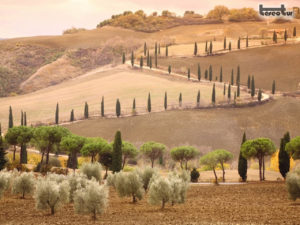
THE VAL D’ORCIA – A Unesco patrimony site, this area in the tuscan lowlands is an iconic place with its unique landscape and nice villages to visit. The main interesting locations in this area are: Pienza small picturesque village, a perfect “renaissance style” village, then, other places to visit: Montalcino, San Quirico d’Orcia, Buonconvento, Bagni San Filippo and Bagno Vignoni.
Near the Val d’Orcia territory you can find another natural attraction: the Mount Amiata It is a rough and wild mountain environment but very charming at the same time. The central spot of this area is Mount Amiata (1738 mt.), a perfect winter stop for ski lovers. This mountain is also great during spring and summer for those who like excursions and trekking.
Around here, Radicofani, Piancastagnaio e Abbadia San Salvatore are three of the main typical towns to be visited.
THE MAREMMA TOSCANA – (the coast)
Capalbio is a gracious medieval town located in south Tuscany, close to the large Tyrrhenian beaches. Nature offers spectacular landscapes with green hills and virgin Mediterranean forests. Places to visit: La Rocca town, an old fifteenth Century “L” shaped building with a rook and a closed courtyard. In it, there is the famous original Giacomo Puccini piano. Around La Rocca, precisely in Sughereto di Ballantino, there are more than 2000 years’ old Roman villas. For those who love nature and sea, a WWF protected oasis can be visited near the Burano lake.
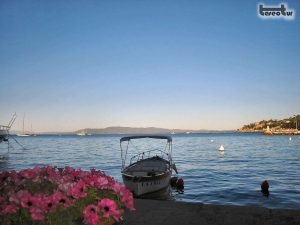
Maremma Toscana (Etruria land) – The so called Etruria is the inland area of the Maremma Tuscany and it is a place which has to be visited for its natural and artistic elements.
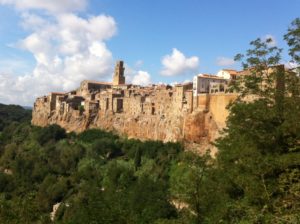
Pitigliano – This town 313 mt osl, on its volcanic rock, shows stunning landscapes and it is surrounded by the Lente and Meleta creeks. Pitigliano underground is shocking: visitors can walk through extraordinary Vie Cave ( ancient dug in the volcanic rock and through more than 60 narrow etruscan-medieval downtown streets). The medieval Orsini Fortress is an important and beautiful place to see. The Archaeological Civic Museum and the Sacred Art Museum are in it. In the end, the last but not the least building to visit is the Pitigliano Duomo, dedicated to S.Peter and S.Paul Apostles, with its late baroque facade end its inner parts with Eighteenth Century golden elements.
Manciano-Saturnia – The charming town of Manciano has the Aldobrandeschi Castle, with its original walls and two of the three doors. At the top of a hill, along the road to Vulci, there is the Roccaccia di Montauto, once owned by the Aldobrandeschi and the medieval Sciarpena Castle. Also Marsiliana is very interesting because of its Etruscans ruins and the Necropolis. Manciano is the famous place where visitors can relax and cure themselves with sulfurous waters in the spa. The extraordinary Gorello water falls created natural tubs which are free for everyone. In the same area, there are several beautiful towns to visit, such as San Quirico, Sorano and Sovana.

